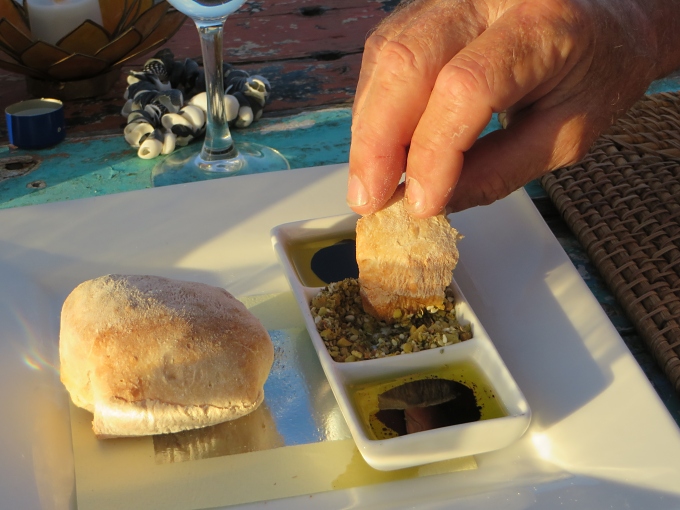Streaky Bay - End of the Seafood Trail
/We went out to dinner last night. It's not something we do often. We were celebrating just being here, being together, living the good life and also the fact we sold our first article to Cruising Helmsman, Australia's premiere cruising magazine. The dinner probably cost more than the magazine will pay for the article, but let's not get mired in the details.
The Eyre Peninsula is home to the largest commercial fishing fleet in the Southern Hemisphere. The waters here are rich with wonderful fish and seafood: oysters, abalone, prawns (shrimp), rock lobster, salmon, tuna. We've been hearing about Venus Bay prawns, Streaky Bay oysters, King George whiting, Kinkawooka mussels, nannigai (which we thought was Nanny Grey...hmm), and Murray cod. Of course, we've been catching our own blue swimmer crabs which are delish, but we thought we might like to try something that someone else had caught … and prepared.
There's an established Seafood Trail on the Eyre Peninsula and, if we had a car, we might be tempted to drive it and sample the epicurean delights along the way. The trail starts in Whyalla and ends in Streaky Bay, but for our purposes, the trail starts AND ends in Streaky Bay … at the Mocean Cafe (pronounced motion … M-ocean). We might not eat out often, but when we do, we try to find a place that offers interesting menus and makes use of local ingredients.
“Mocean specialises in creative regional seafood with native flavours, using Australian bush herbs & spices to enhance the local bounty from the sea. One of few Australian restaurants to offer abalone year round, Mocean explores the use of by-catch seafood such as the signature sea salt & native pepper stingray.” How can you pass this up?
Mocean came highly recommended by many of our fellow cruisers and it certainly deserves the praise. We loved it. It's right on the waterfront and we had a table outside on the porch overlooking the bay with a good view of Nine of Cups and the jetty. It was a romantic setting. The only other guests on the porch with us were a couple of cheeky locals who insisted on watching us eat.
Margii, one of the owners, offered suggestions, explained the evening's specials and took our order. She was attentive without being intrusive … a true art. She was aware we were from a yacht and midst courses, asked questions about sailing. Another server, Jenny, stopped by to say hello as well. In a small town … news travels fast OR we looked like boat people?
We shared a starter of marinated King George Whiting served with a mustard sour cream and fresh rocket on crostini. We could have stopped right there and just ordered more appetizers, because the fish was melt-in-your-mouth wonderful.
We also shared a saltbush macadamia dukkah. It's not fish, but we were just introduced to it here in Australia and loved it. Dukkah (pronounced doo-kah) is an Egyptian blend of herbs, seeds, nuts and spices and is served with fresh bread, extra virgin olive oil and balsamic vinegar. You break off a chunk of bread, dip it in the oil and vinegar and then dip in the dukkah. It was perfect with a crisp white pinot gris and the King George Whiting.
David ordered a whole baked nannigai as his main which was a special for the evening. It looks and tastes like red snapper and was served on baby new potatoes and stuffed with lemons and an accompaniment of black and green olives. My taste verified it was definitely acceptable.
As for me, I ordered seafood marinara. It was outstanding, chock full of local fish, mussels, prawns, squid and scallops in a tomato-saffron based sauce served on fettucine with fresh basil and shaved parmesan topping. Manna of the gods. I was in heaven.
We watched the sun set. The tiniest bit of crescent moon had risen and it became cool and windier. Margii moved us to an inside table, so we could enjoy the rest of our meal. Most all the tables were full and people seemed to be enjoying themselves in a comfortable setting, the delectable smells of different dishes permeating the room.
No room for dessert. We dragged the dinghy back into the bay, feet all sandy and cold from the sea water. A short, cold dink ride and we were back aboard Cups, warming up with a brandy and savoring the evening. I'm glad we don't do this often; it wouldn't be as special.

















